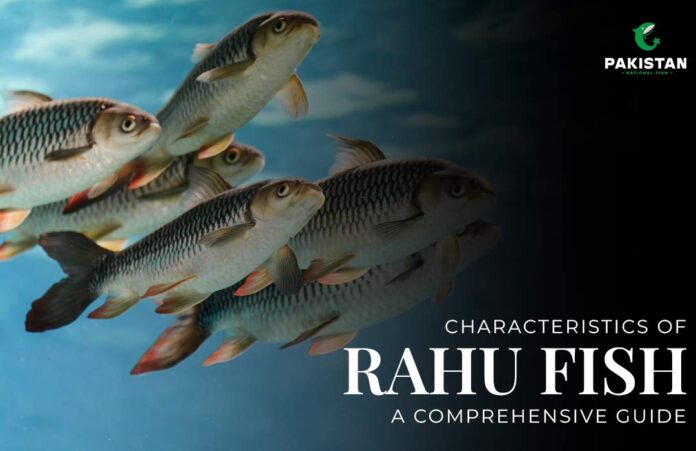The Rohu fish, commonly known as Labeo rohita, is a freshwater fish species that lives in South Asia. This type of fish is not only an essential component of the ecology, but it also provides nutrition and income for millions of people. It is extensively produced and consumed in a variety of cultures due to its flavour and nutritional value.
This carp fish refers to the Cyprinidae family. Rohu fish is the most valuable type of carp fish. It’s incredibly tasty and excellent. Typically, it is a river fish but, it is found in all types of natural water reservoirs. Surmai fish and Mushka fish, in addition to rohu, are popular in many Asian countries. This detailed guide examines the traits, habitat, eating habits, and significance of Rohu fish.
Physical Characteristics of Rohu Fish
Rohu fish is distinguished by its huge size, silver body, and unique head form.
Rohu is a eurythermal species that does not live at temperatures below 14 degrees Celsius. It is a fast-growing species that can reach 35-45 cm in overall length and 700-800 g in a single year under standard culture conditions. In polyculture, it grows faster than mrigal but slower than catla.
Here is an in-depth examination of its physical characteristics:
- Body Shape: The Rohu features a sleek body with a slightly curved back and a rounded nose.
- Measurement: It may grow to be up to 2 meters long, but most examples are between 50 and 100 cm.
- Weight: Adult Rohu may exceed 45 kg, however, their median weight is between 2 and 5 kg.
- Colouring: The body is normally silver with a golden tint to the scales, and the fins are red.
Dietary Habits of Rohu Fish
Rohu fish, a popular freshwater fish in South Asia, has dietary habits influenced by its natural habitat and physiology.
- Feeding: Rohu fish are omnivorous and prefer a plant-based diet. They are recognized for the following eating habits:
- Herbivorous Trends: Feed mostly on phytoplankton, algae, and vegetation that is submerged.
- Supplemental Diet: Infrequently ingest tiny invertebrates and organic debris.
Lifecycle of Rohu Fish
The lifecycle of rohu fish encompasses several stages, each critical for their development and survival. Here is an overview of their lifecycle:
- Breeding Habits: The spawning process occurs during the monsoon season, which normally lasts from June to September and causes water levels to rise.
- Egg Laying: Females lay hundreds of eggs in water, which are externally fertilized by males.
- Larval Phase: Hatchlings hatch within 18-24 hours and are initially fed from the yolk sac.
- Junior Stage: After a few weeks, they start feeding on plankton and grow quickly.
- Adult Stage: Sexual maturity occurs between 2-3 years, subject to environmental conditions.
Rohu fish might survive up to 10-14 years in the wild, however, this may vary depending on environmental variables and predators.
Amazing Facts about Rohu Fish
Here are some amazing facts about rohu fish:
- Fast-growing Rohu is noted for its high growth rate, making it a popular choice for the aquaculture sector.
- It is frequently used in cultural and religious activities throughout South Asia.
- Grows in a variety of habitats, indicating resistance to environmental change.
- Rohu are highly adaptable to various water conditions, which contributes to their widespread use in aquaculture.
- They help control the population of bottom-dwelling organisms and contribute to nutrient cycling.
Health Advantages of Rohu Fish
Eating Rohu fish is an excellent source of important nutrients, making it a popular choice among health-conscious consumers.
- Protein: High-quality protein for muscle growth and repair.
- Omega-3 Fatty Acids: Improves heart health and memory.
- Vitamins and minerals: High in vitamin D, B vitamins, calcium, and phosphorus.
- Heart Health: Omega-3 fatty acids in Rohu help to improve heart function by reducing inflammation and high blood pressure.
- Brain Function: Necessary fatty acids promote brain health and cognitive functioning.
- Bone Health: High in phosphorus and calcium, which are essential for strong bones and teeth.
Conclusion
The Rohu fish is a fascinating species that has tremendous ecological, economic, and health benefits. Its flexibility and appeal in aquaculture make it an important resource for both food and livelihoods in South Asia. Understanding its traits, habitat, and eating habits allows us to grasp its importance to ecosystems and human communities.
Preservation initiatives and environmentally friendly methods are essential for safeguarding the supply of Rohu fish for generations to come. As consumers, purchasing properly sourced Rohu can help to ensure the survival of this important species.


